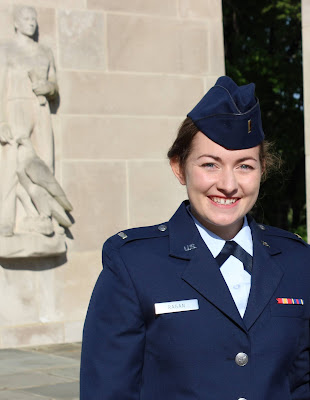This guest post is from Mary Claire Taylor, Regent Family Law student:
One of the newest fields of family law revolves around
artificial reproductive technology (ART), a method to help build families.
Lawyers, clients, and courts are being forced to address controversial
questions that meddle with rights of parents, marital property, and even
contract law. A prominent arena where this is being played out is within the United
States Military. Recently, the Army
and Air
Force created cause for celebration for sisters-in-arms with a change in
dress and appearance standards – a new era of pony tails, earrings, and
lipstick. After addressing the appearance of female members, will the military
be able to address a female’s reproductive nature as well?
ART is being used more
frequently than ever before to help women who struggle to conceive. Generally,
ART encompasses different procedures with the end goal being to help give an
infertile woman a child by joining an egg and sperm together. The military,
through TRICARE regulations, uses the term Assisted
Reproductive Services. By that definition, TRICARE will cover diagnostic
services for infertility. However, TRICARE will not cover the technological
processes that help a woman conceive, unless infertility was caused by an
illness or injury while on active duty, which can be difficult to prove a
direct causation. Even with that small exception, full coverage is not
guaranteed. However, TRICARE does cover male
and female sterilizations.
To cover or not to cover? The debate against TRICARE covering
ART creates controversy.
Economically, if the military considers ART to be an elective procedure, then there
is opposition to using tax dollars to pay for unnecessary medical procedures. Morally,
objectors to ART do not want frozen embryos to be destroyed – a possibility for
those undergoing In Vitro Fertilization (IVF) where an egg is fertilized
outside the woman’s body. Additionally, if a couple uses IVF and later divorce,
it may not be clear how the leftover embryos are treated – are they subject to
marital property or contract law or both? Another moral objection may come from
those who oppose same-sex couples to use ART procedures when conception cannot
happen naturally.
Women who need ART to conceive, however, are left to face
costly procedures. The average cost of an IVF cycle – the most common form of
ART – is $23,000. The
reality is that most couples need multiple cycles bringing the cost close to
$50,000. TRICARE and money aside, the climate of the military has not yet
gotten up to speed with how to approach this medical and emotional endeavor.
Misunderstandings compound an already challenging procedure for women.
Infertility is not easily diagnosed, and there are many
factors which contribute such as age, stress, and hormone imbalances. Private
issues of family planning may become public and uncomfortable. A member may
have to explain to superiors the reasons for requesting leave or coming in
late, but not actually know “why” she is having infertility problems. Women have
started to speak
up about how the military can make an already difficult treatment feel
impossible. High stress jobs, maintaining weight and fitness standards while
using fertility medication, involving Chain of Command in an emotional process,
having to use leave in order to attend treatments, and as discussed above, the
high cost of treatments. Not only do these factors impede infertility
treatment, but they also can contribute to infertility.
Finally, the regulations within each branch are likely not
up-to-date on addressing ART. Specifically, the Air Force Instructions (AFIs)
address pregnancy and post-partum. These include exceptions to maintaining weight
and fitness standards, getting temporary
job assignments for safety measures, and physical
training (PT) exemptions.
The Air Force is just now getting used to females wearing
ponytails in uniform. It may be a while until the service branches are ready to
fully address reproductive issues for women to help them build their families.




No comments:
Post a Comment